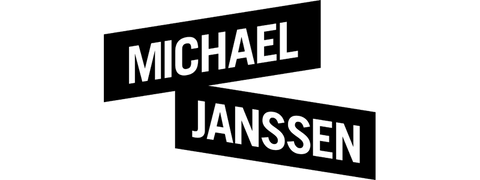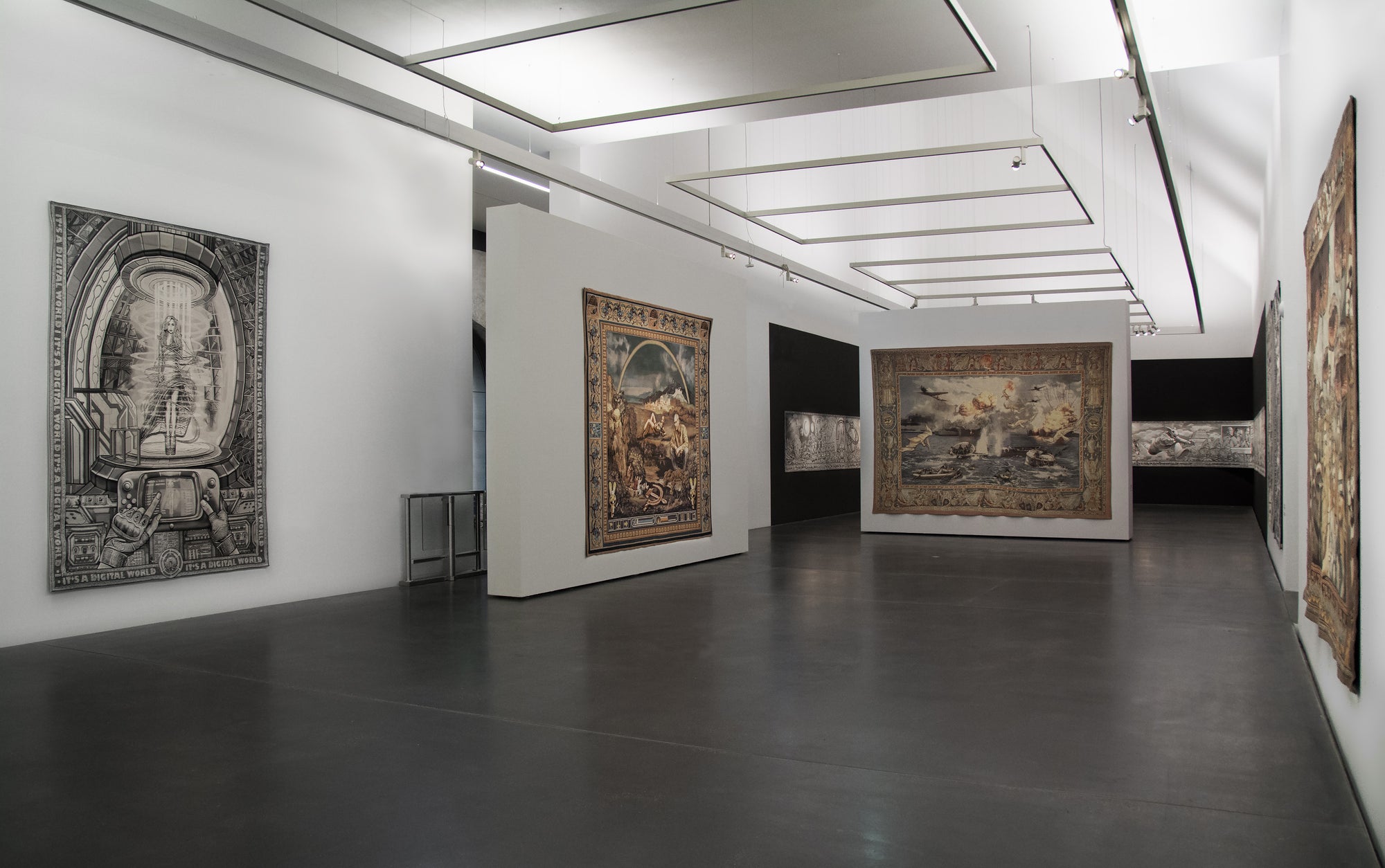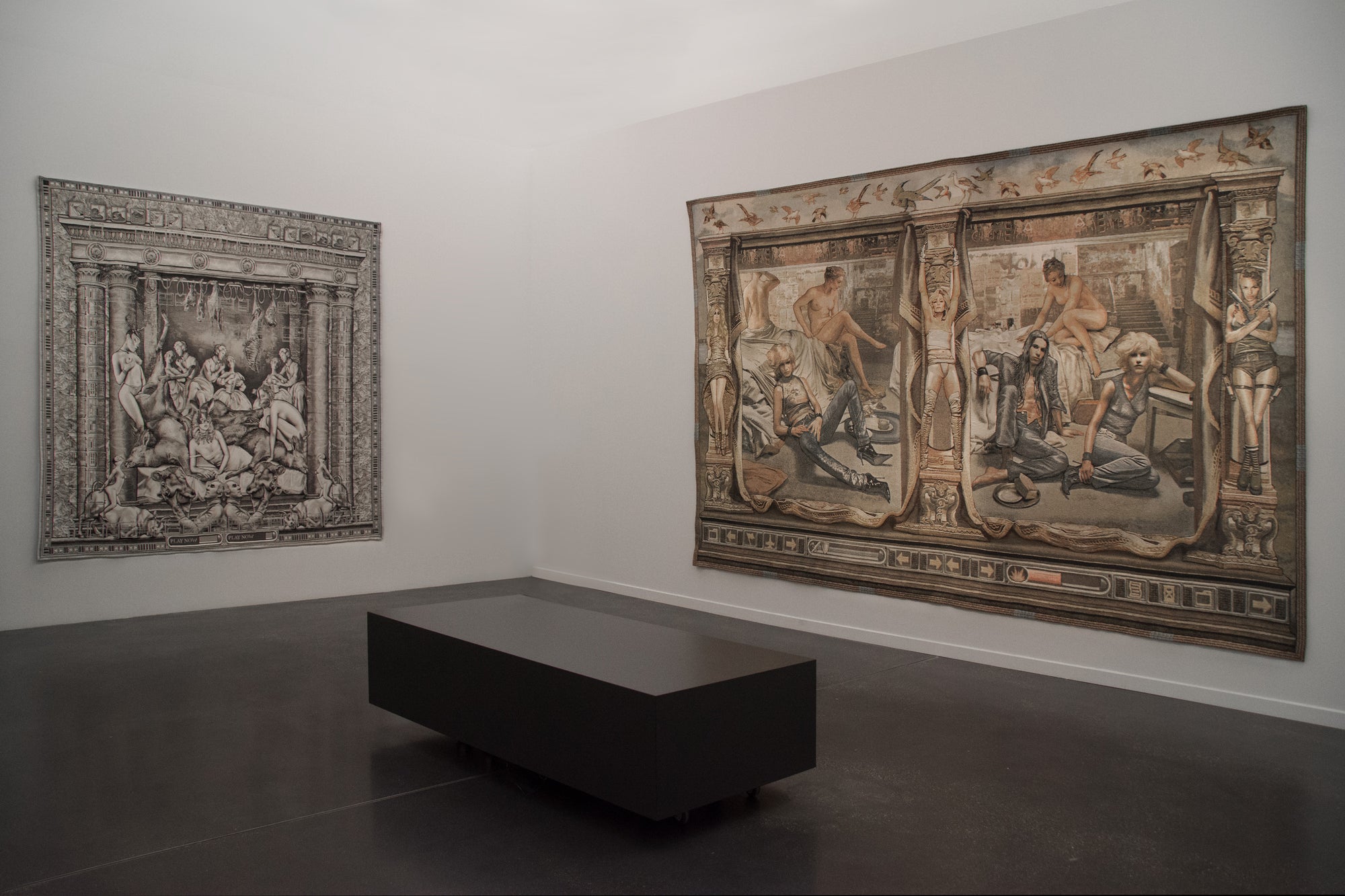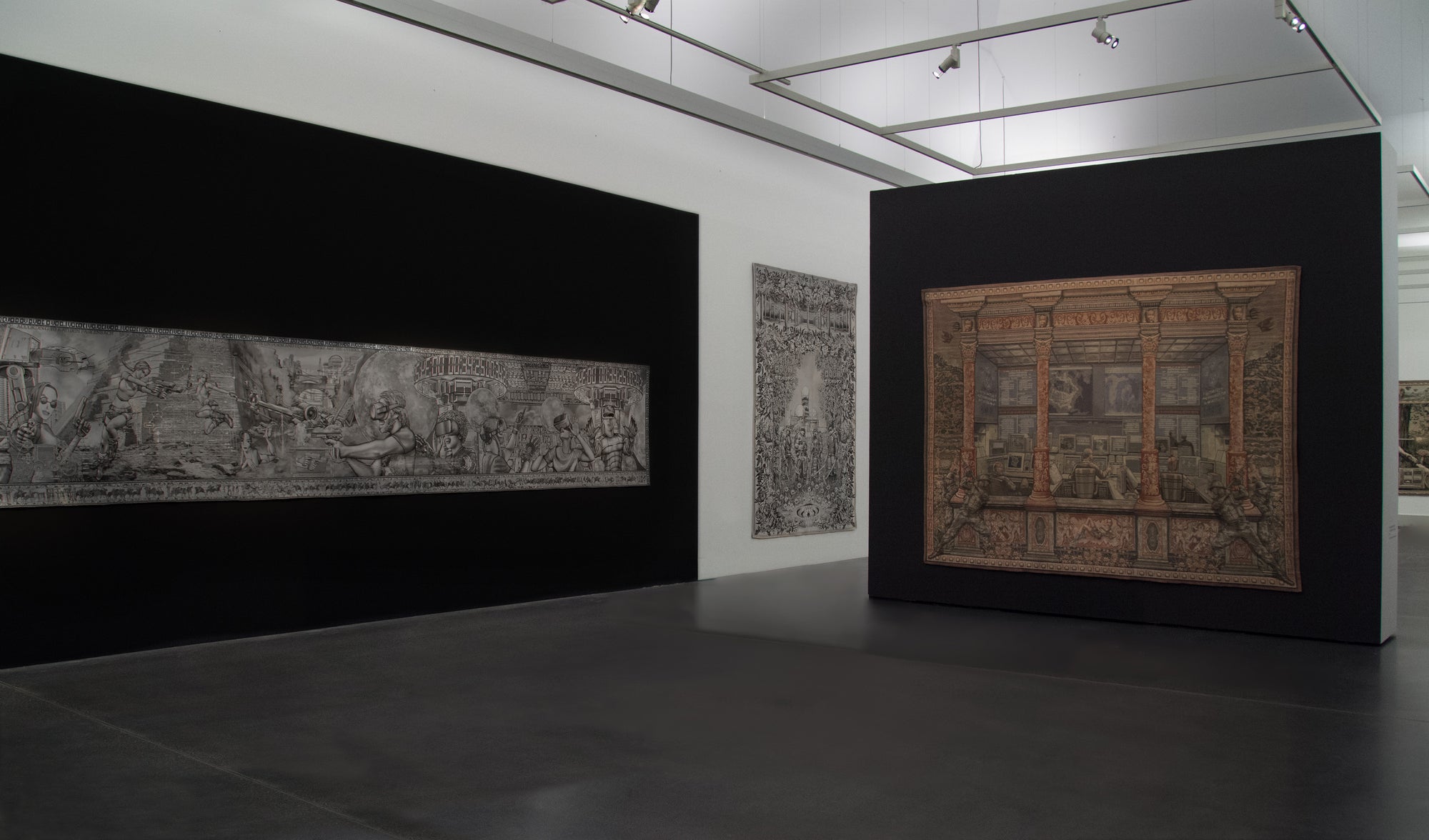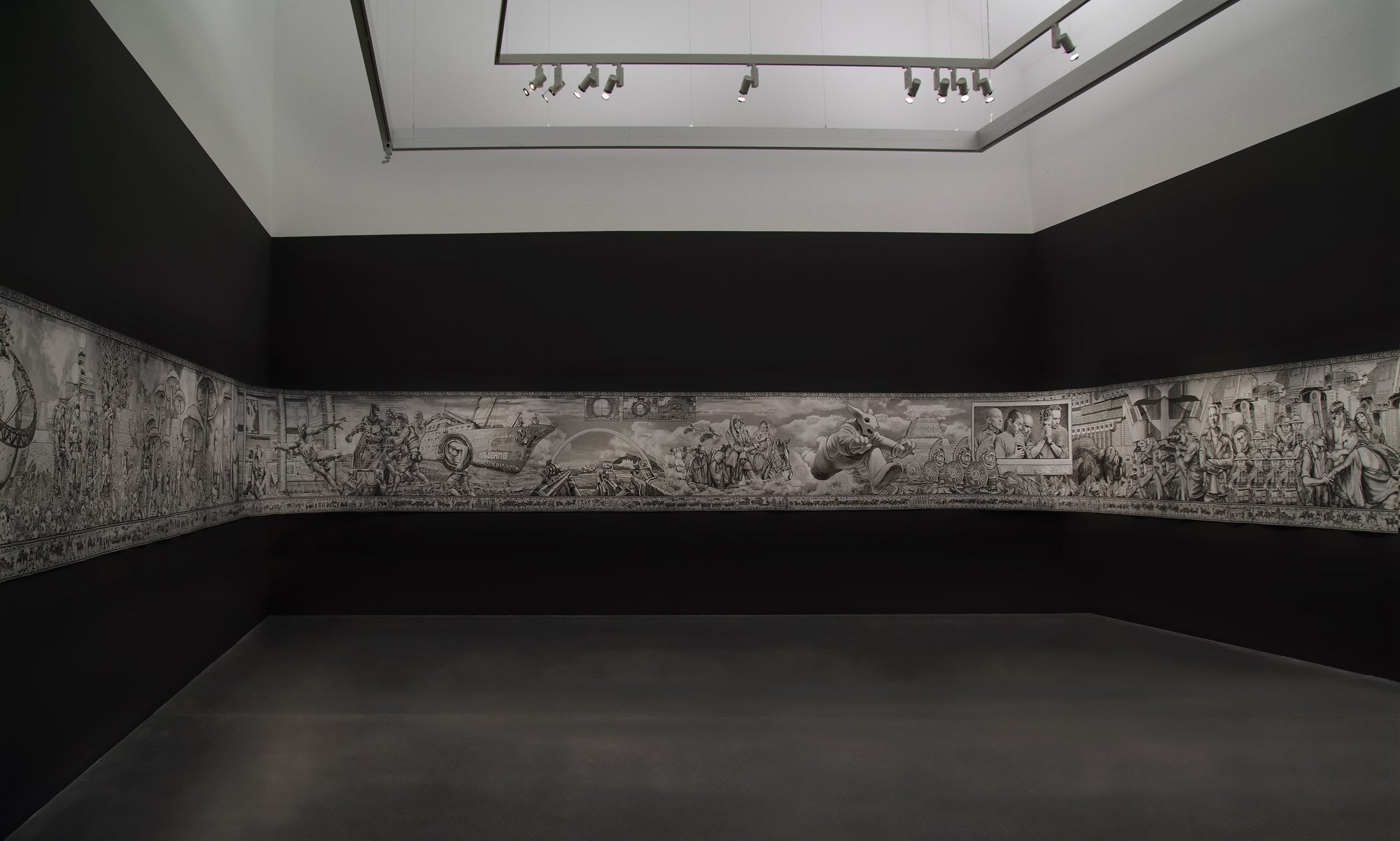Margret Eicher - Battle:Reloaded
1 October 2022—8 January 2023
Opening: Friday 30 September, 7 pm
Kunstmuseum Moritzburg, Halle (Saale)
- Download: Exhibition Portfolio ( EN / DE )
- To accompany the exhibition, a limited edition artist's book will be published as an elaborately handcrafted leporello, which can be folded out to a length of 5 metres and is stored in a high-quality slipcase.
- For press inquiries, please contact: Aleksandra Beeker, aleksandra@galeriemichaeljanssen.de, +49 30 259 272 50
Battle:Reloaded. A Tapestry Panorama by Margret Eicher
Sebastian Baden
War is the father of all media, and the scene of vicious crimes committed by human beings against one another. The violence of war occurs everywhere, both on the battlefield and in visual culture. Overcoming one’s opponent is not just a physical but also a psychological part of warfare with the result that images are also not neutral; they are an element of the cultural technique of war, just like weapons. Media and war are caught up in a symbiotic relationship with one another, a relationship that the media philosopher Paul Virilio analysed critically in many instances. (1)
In the process of transmitting the history of mankind, war occupies a large part of the news, and the related narrative of victory and defeat forms the basis of cultural identities. From Antiquity to the present day, war has been inscribed in the cultural history of mankind. What once happened is passed down to us and eternalised in written documents, sometimes it is even chiselled in stone or embroidered on fabric, as the finds preserved and exhibited in museums testify.
When war is waged in our day, the media present the events in printed and digital versions; they produce images of the events and preserve these in media memory. Images of war themselves fuel a war of images. Images of battles and war reportages shape visual culture and are also reflected in the images which constitute art. For this reason, the cultural theorist Boris Groys holds artists responsible when it comes to passing on a record of war: “The artist needed the warrior so as to have a theme for an artwork, but the warrior needed the artist even more. After all, the artist could also find another, more peaceful theme for his work, whereas the warrior’s fame, and the safeguarding of that fame for coming generations, could only be guaranteed by the artist. In a certain sense, heroic action in war was meaningless and irrelevant without an artist with the power to bear witness to that heroic act and inscribe it in the memory of mankind.” (2) In the history of visual culture, war reportages mark important stages in the assumption of power. What are retained in cultural memory are the grand gestures of the victors. Aleida Assmann has dedicated extensive research to this link between media, social memory and trauma. (3)
The Trojan War, the Battle of Alexander at Issus, Constantine’s victory at the Milvian Bridge, the Song of Roland and other ancient and medieval battles have been handed down to us as legends not only because they imprinted themselves on the memory of those who witnessed them, but also because over and over again and in ever new forms they were absorbed into stories through works of art, such as literature and paintings. In the same way, current wars like those being waged in Syria, Sudan, Yemen or Ukraine, will become incorporated into the history of the media and culture.
With her latest work the concept artist Margret Eicher has written herself into the history of war images. Yet she is not a war reporter who takes and publishes photographs of the horror. As an artist she works with the media memory of cultural history and the narratives of popular culture, which latter has integrated war as a master story. Entitled Battle:Reloaded, her latest contribution is a 30-meter-long tapestry, made in a continuous digital work process from the compositional collage of the motif to production on state-of-the-art Jacquard looms at a Belgian weaving mill. This way, Margret Eicher has been creating her impressive large-format tapestries for more than 20 years. Her favourite themes are motifs from popular cultures which she gleans from films, advertisements, fashion or gaming. The artist avails herself freely of the diversity of these media, excising iconic motifs, poses and symbols and assembling them anew. This cultural technique of “mashing up” tends to be located in contemporary digital media culture, given that there it is quite easy to quickly sample motifs and melodies and, ultimately, metaphors, in order to generate new meanings. Aby Warburg examined the analogue use of such pictorial techniques throughout art history and established the use of pathos formula and so-called image vehicles. As regards mythological and also simple, worldly depictions, Warburg posited the thesis that over the course of cultural history images and ideas spread and are adapted in order to depict new events. (4)
It is possible to observe a similar process in Margret Eicher’s new work. On the large-scale tapestry we see a series of about ten interlinked scenes. Beginning with a fictional depiction of the Big Bang, and including the four Ninja Turtles, this parcours of popular cultural citation takes us from Julian Assange and Lara Croft to masked female model-figures and an augmented reality generated by computers. In between there are repeated moments involving violence, firearms, flight, expulsion or super-heroes like Spider Man and Batman who stand up to Evil.
Here Margret Eicher has brought together her observations from different image sources in order to construe a highly varied and at the same time disturbing image of contemporary visual culture. She has filtered the stereotypes and idealised role models out of the digital narratives and in doing so inscribed a gender and media critical perspective into the fictional stories. The artist Margret Eicher defies a heteronormative culture replete with role models that draw their supposed prototypes from the narratives of patriarchal power relations. In between these, the kitschy group of Pokémon comic figures romp around. What is more, above the images in the decorative border and at the lower edge, there are text and image citations that pursue a very specific trail into art history and cultural theory. This is about nothing less than the cultural technique of conquest and appropriation on the one hand, and on the other, intellectual resistance to power structures.
The artist has quite deliberately chosen the format of the tapestry. Whereas up till now she has used rectangular upright and landscape formats for her pictorial works, she has chosen the panorama for her latest. This format opens up the pictorial space to the right, in the direction of reading, and so follows an unfolding story. The unusual form is due to an extraordinary model: the famous Bayeux Tapestry depicting the Battle of Hastings in 1066. That work was commissioned around the middle of the 11th century by Bishop Odo and is an outstanding contemporary document and part of the world cultural heritage. Directly after the event illustrated, the invasion of England by the Normans under Wilhelm the Conqueror, the story was embroidered on an almost endless piece of cloth. That 70 metre long and 52 centimetre high “comic strip” reports, in 58 scenes, on the waging of the war, the sea crossing, the invasion, the battle and the victory over the English army. The details of the scenes, the delicate depiction, the movements and gestures of the figures are all masterfully executed and still elicit astonishment in people to this very day. The depiction – on an embroidered cloth – was intended as a decoration for the new Cathedral of Bayeux consecrated in 1077, where it would perpetuate the fame of the Noman leader.
Margret Eicher has appropriated this representation of events and media spectacle from the Middle Ages for her own work. At the lower edge of the depiction, scenes from the Battle of Hastings run as a citation along the bordure, thus ‘hemming’ the central picture collage. The artist therefore calls her work Battle:Reloadedand with it she continues the story of wartime events up to the present-day Hollywood blockbusters, whose narrative patterns adhere to the same pattern. Heroism and war, the self-representation of power and the self-staging of stars are all part of a “culture industry” the seductive power of which Max Horkheimer and Theodor W. Adorner severely criticised in their Dialectic of Enlightenment (5). Margret Eicher explores this critical Zeitgeist and interweaves it with images of idols and the iconography of the imaginary hero and heroine.
Pre-Columbian pyramids, antiqued columns and Romantic landscapes structure the backdrop, while figures from the universe of Star Wars or Heath Ledger alias Joker pose in front of them. Amidst towering ice floes from Caspar David Friedrich’s painting The Sea of Ice (also: The Wreak of Hope) lies the murdered King Kong, a symbol of a nature that is eternally good and the father figure of cinematic special effects.
Thus, citation by citation, Margret Eicher stages a dramatic sequence of scenes. This appropriation of famous icons from the history of art and of culture lends Battle:Reloaded a daring meta-level. The artist overwrites the canonical narrative of the cultural history of power and then, in a showdown, aims the image-as-weapon at the very image culture that she is citing. The immersion of the panorama gives rise to the iconoclastic implosion of a western image culture. Margret Eicher provides us with an image repertoire from both present-day pop culture and art history, seduces us into a nostalgic study of the media and overlays it with science’s critique of the media: “Strategies and forms of warfare are changing radically as a result of digitization. […] World events are becoming unpredictable.” (6)
—
Sebastian Baden is an art historian who did his doctorate at the Staatliche Hochschule Karlsruhe (HfG) on Das Image des Terrorismus im Kunstsystem (The Image of Terrorism in the Art System). He was curator for sculpture, contemporary art and the new media at the Kunsthalle Mannheim and since July 2022 has been director of the Schirn Kunsthalle Frankfurt am Main.
—
Footnotes:
[1] Paul Virilio: War and Cinema: The Logistics of Perception (Fr. 1984), London New York 1989; idem.: War and Television (Fr. 1991).
[2] Boris Groys: The Fate of Art in the Age of Terror, in: idem.: Die Kunst des Denkens, ed. and with an afterword by Peter Weibel, Hamburg 2008, pp. 49–67, 49.
[3] Aleida Assmann, Jan Assmann: Das Gestern im Heute. Medien und soziales Gedächtnis, in: Klaus Merten, Siegfried J. Schmidt, Siegfried Weischenberg (eds.): Die Wirklichkeit der Medien. Eine Einführung in die Kommunikationswissenschaft, Opladen 1994, pp. 114–140.
[4] Martin Warnke: Vier Stichworte: Ikonologie – Pathosformel – Polarität und Ausgleich – Schlagbilder und Bilderfahrzeuge, in: idem.: Werner Hoffmann, Georg Syamken: Die Menschenrechte des Auges. Über Aby Warburg, Frankfurt/M. 1980, pp. 53–83.
[5] Max Horkheimer, Theodor W. Adorno: Dialectic of Enlightenment. Philosophical Fragments [New York 1944].
[6] Yvonne Hofstetter: Der unsichtbare Krieg. Wie die Digitalisierung Sicherheit und Stabilität in der Welt bedroht, Munich 2019.
